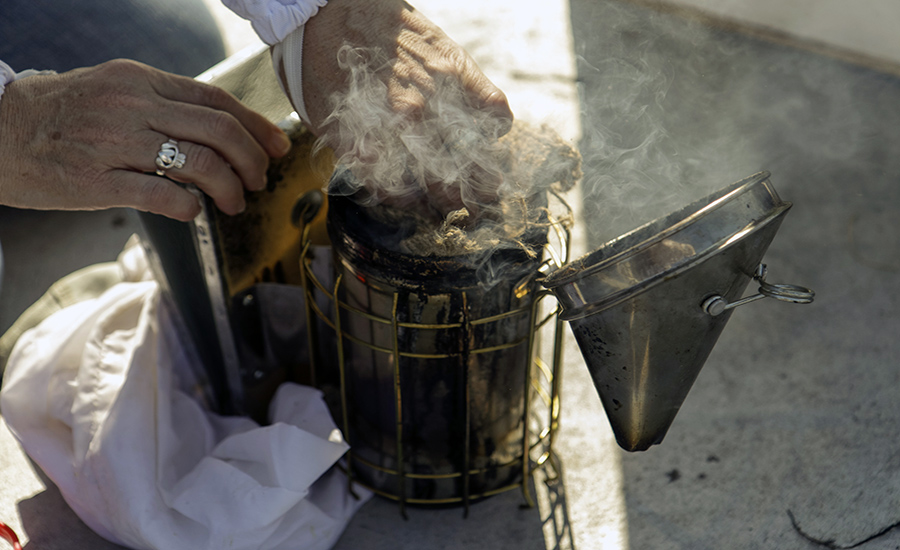
QUEENS – After 14 years as a sales manager for a wine distributor, Queens local Tom Wilk took up beekeeping as a hobby in 2012. At first, it was simply a reprieve from his day job. He had no environmental agenda and was not trying to join a trend. But after his first hive, he was hooked.
“When I do something, I don’t do it a little,” Wilk said. “The first year I had three hives, nine the second, 12 the third. I have 24 now. It’s fun. It’s good for the environment. Man, I don’t know how many I’ll have next year. Probably more.”
He started selling the honey from his collection of beehives – Wilk Apiary Inc. – at a farmer’s market in Grover Cleveland High School four years ago. His brand, “Zip Code Local Honey,” has grown in popularity, mirroring the national trend favoring local produce.
Wilk’s two-dozen hives are at several neighborhood markets in Queens: in Long Island City, Astoria, Maspeth, Glendale and Ridgewood. But for Wilk, it’s not about the money.
“I sell the honey to help fund the hobby,” Wilk said. “But I pay out of pocket still.”
Wilk says he’s close to breaking even because people like his honey, but it’s not an industrial operation by any means. Sometimes it can take a couple seasons for a hive to develop.

Beekeeping as a hobby has exploded in NYC since it became legal in 2010. In 2014, there were 99 registered beekeepers and 261 hives, according to the New York City Department of Health and Mental Hygiene.
Animal pollinators like honey bees contribute to 35 percent of global food production. And while there is no precise way to measure the impact urban hives have, recent statistics from the USDA show bee numbers are the highest they’ve been in 20 years.
Andrew Cote, a founding member of the New York City Beekeepers Association, said that since the organization was founded in 2008, it has grown from half a dozen members to several hundred.
Wilk’s passion is most apparent when he is interacting with his patrons. He has accumulated a sizable group of regulars and is playful with his customers’ children. When answering questions about the honey and the flavor differences between the various types he offers, he is knowledgeable, leveraging his experience from talking about wine.
“When I try to describe the taste, I want to capture all the nuance. Not just flavor but the body, the viscosity, the mouthfeel—it’s important,” Wilk said.

The difference in honey’s flavor across seasons can be attributed to the water content in the flowers’ nectars during the different seasons, Wilk explained. In the fall months, the nectar contains less water and so the honey ends up being more dense and sweet than honey from spring harvests, which are more light and subtle in their sweetness, he said.
“One of my favorite tastings to do is honey from the same hive but harvested in spring, summer and fall. You can really taste the difference,” he said.
At his stand at the Ridgewood Market during the fall’s harvest season, Wilk fielded questions from patrons about his honey, which he sells for $25 a bottle.
“People are more interested now,” he said. “It’s great. Sometimes I go home and I have no voice because I’ve been explaining honey for the last six hours.”
At this point, Wilk has established a name for himself among locals and his stand at the Ridgewood Market is always busy.
Trevor McGrath, 36, a consulting chef in Manhattan, is a fan of Wilk’s. McGrath has become such a big proponent of Wilk’s product that he even shot a commercial focusing on small local business, advocating for the honey.
“I’ve been big into local stuff and farm-to-table forever, so when I heard about his honey, I had to see it,” McGrath said. “I got to use the smoke machine on the bees and was pretty soon enjoying myself.”

“When I first started I was begging people to put hives in their backyards or roofs,” Wilk said. “Now people come to me. We turned down three people this year.”
Wilk’s wife of 32 years, Barbara, helps her husband tend to the bees and extract the honey from the hives. She says that it is something her husband and she do together that is relaxing and meditative. She admitted that initially she was apprehensive about partaking in her husband’s hobby, but after so many years together, she’s not surprised she eventually developed a passion for the practice as well.
“When you live with Tom, life is an adventure,” she said.
As Barbara and Tom checked up on their hives in Ridgewood on a crisp Friday morning in September, the zen-like atmosphere immediately became apparent. With barely a word uttered to each other, they fell into their roles tending to the hives with calm, deliberate movements. The bees did not seem to mind it.
